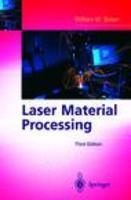 29.0%OFF
29.0%OFF

Download App
 29.0%OFF
29.0%OFF
Laser Material Processing, 3rd Edition
-
ISBN
:
9788181288806
-
Publisher
:
Springer (sie)
-
Subject
:
Others
-
Binding
:
Paperback
-
Pages
:
408
-
Year
:
2008
₹
2390.0
 29.0% OFF
29.0% OFF
₹
1696.0
Buy Now
Shipping charges are applicable for books below Rs. 101.0
View DetailsEstimated Shipping Time : 5-7 Business Days
View Details-
Description
Lasers now play a major part in processing of the disparate materials used in engineering and manufacturing. The range of procedures in which they are involved is ever increasing. With this growing prominence comes a need for clear and instructive textbooks to teach the next generation of laser practitioners. The informal style of Laser Material Processing (3rd Edition) will guide you smoothly from the basics of laser physics to the detailed treatment of all the major materials processing techniques for which lasers are now essential. ¢ Helps you to understand how the laser works and to decide which laser is best for your purposes. ¢ New chapters on bending and cleaning reflect the changes in the field since the last edition completing the range of practical knowledge about the processes possible with lasers already familiar to users of this well-known text. ¢ Provides a firm grounding in the safety aspects of laser use. ¢ Professor Steen's lively presentation is supported by a number of original cartoons by Patrick Wright and Noel Ford which will bring a smile to your face and ease the learning process. Laser Material Processing (3rd edition) will be of use as university or industrial course material for senior undergraduate, graduate and non-degree technical training in optoelectronics, laser processing and advanced manufacturing. Practising engineers and technicians in these areas will also find the book an authoritative source of information of the rapidly expanding use of industrial lasers in material processing. Subjects of the book : Engineering Contents of the book : Prologue 1 Background and General Applications 1.1 How the Laser works 1.2 Types of Industrial Lasers 1.3 Comparison Between Lasers 1.4 Applications of Lasers 1.5 Market for Laser Applications 2 Basic Laser Optics 2.1 The Nature of Electromagnetic Radiation 2.2 Interaction of Electromagnetic Radiation with Matter 2.3 Reflection or Absorption 2.4 Refraction 2.5 Interference 2.6 Diffraction 2.7 Laser Beam Characteristics 2.8 Focusing with a Single Lens 2.9 Optical Components 3 Laser Cutting 3.1 Introduction 3.2 The Process - How It Is done 3.3 Methods of cutting 3.4 Theoretical Models of Cutting 3.5 Practical Performance 3.6 Examples of Applications 3.7 Costed Example 3.8 Process Variations 3.9 Future Developments 3.10 Worked Example of Power Requirement 4 Laser Welding 4.1 Introduction 4.2 Process Arrangement 4.3 Process Mechanisms - Keyholes and Plasmas 4.4 Operating Characteristics 4.5 Process Variations 4.6 Applications 4.7 Costed Example 5 Heat Flow Theory 5.1 Introduction 5.2 Analytic Models in One-dimensional Heat Flow 5.3 Analytic Models for a Stationary Point Source 5.4 Analytic Models for a Moving Point Sources 5.5 Alternative Surface Heating Models 5.6 Analytic Keyhole Models - Line Source Solution 5.7 Analytic Moving Point-Line Source Solution 5.8 Finite-difference Models 5.9 Semi-quantitative Models 5.10 Flow Models 5.11 Stress Models 5.12 Conclusions 5.13 List of Symbols 6 Laser Surface Treatment 6.1 Introduction 6.2 Laser Heat Treatment 6.3 Laser Surface Melting 6.4 Laser Surface Alloying 6.5 Laser Cladding 6.6 Particle 6.7 Surface Texturing 6.8 Enhanced Electroplating 6.9 Laser Chemical Vapour Deposition 6.10 Laser Physical Vapour Deposition 6.11 Non-contact Bending 6.12 Magnetic Domain Control 6.13 Laser Cleaning and Paint Stripping 6.14 Surface Roughening 6.15 Scabbling 6.16 Micro-machining 6.17 Laser Marking 6.18 Shock Hardening 6.19 Conclusions 7 Rapid Prototyping and Low-volume Manufacture 7.1 Introduction 7.2 Range of Processes 7.3 CAD File Manipulation 7.4 Layered Manufacturing Issues 7.5 Individual Processes 7.6 Rapid Manufacturing Technologies 7.7 Applications 7.8 Conclusions 8 Laser Bending or Forming 8.1 Introduction 8.2 The Process Mechanisms 8.3 Theoretical Models 8.4 Operating Characteristics 8.5 Applications 8.6 Conclusions 8.7 Glossary 9 Laser Cleaning 9.1 Introduction 9.2 Mechanisms of Laser Cleaning 9.3 An Overview of the Laser Cleaning Process 9.4 Practical Applications 10 Laser Automation and In-process Sensing 10.1 Automation Principles 10.2 In-process Monitoring 10.3 In-process Control 10.4 “Intelligent” In-process Control 10.5 Conclusions 11 Laser Safety 11.1 The Dangers 11.2 The Standards 11.3 The Safety Limits 11.4Laser Classification 11.5 Typical Class 4 Safety Arrangements 11.6 Where Are the Risks in a Properly Set Up Facility? 11.7 Electrical Hazards 11.8 Fume Hazards 11.9 Conclusions Epilogue Index












 1696.0
1696.0







